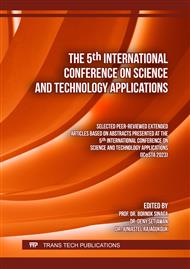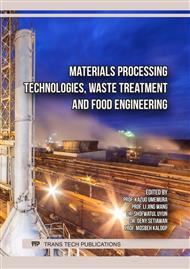[1]
L. Parinduri, T. Parinduri, Konversi Biomassa Sebagai Sumber Energi Terbarukan, J. Elec. Tech. 5 (2020) 88 - 92.
Google Scholar
[2]
R.R. Amin, R.R. Sova, D.I. Laily, D.K. Maharani, Studi Potensi Limbah Tembakau Menjadi Bio-Oil Menggunakan Metode Fast-Pyrolysis Sebagai Energi Terbarukan, J. Kim. Ris. 5 (2020) 151.
DOI: 10.20473/jkr.v5i2.22513
Google Scholar
[3]
N. Febrianti, F. Filiana, P. Hasanah, Potential of Renewable Energy Resources from Biomass Derived by Natural Resources In Balikpapan, J. Presipitasi Media Komun. Dan Pengemb. Tek. Lingkung. 17 (2020) 316–323.
DOI: 10.14710/presipitasi.v17i3.316-323
Google Scholar
[4]
P. Papilo, E. Hambali, R. Fariz Pari, Penilaian Potensi Biomassa Sebagai Alternatif Energi Kelistrikan, J. PASTI. IX (2016) 164–176.
Google Scholar
[5]
Z. Al-hamamre, M. Saidan, M. Hararah, K. Rawajfeh, Wastes and biomass materials as sustainable-renewable energy resources for Jordan, Renew. Sustain. Energy Rev. 67 (2017) 295–314.
DOI: 10.1016/j.rser.2016.09.035
Google Scholar
[6]
U.S. Ramli, Characterization of Apigenin and Luteolin Derivatives from Oil Palm ( Elaeis guineensis Jacq.) Leaf Using LC − ESI-MS/MS, J. Agri. Food Chem. 60 (2012) 11201 - 10.
DOI: 10.1021/jf303267e
Google Scholar
[7]
M. Arief, R. Adawiyah, Nilai Ekonomi Pemanfaatan Limbah Kelapa Sawit, J. Agripita. 5 (2018) 825–837.
Google Scholar
[8]
R. Azri, S. Bahri, Aman, Pirolisis Biomassa Pelepah Sawit Menjadi Bio-Oil Dengan Katalis Natural Zeolit Dealuminated (NZA), Jom FTEKNIK. 1 (2014) 1–11.
DOI: 10.31315/e.v11i1.325
Google Scholar
[9]
S. Wibowo, Karakteristik Bio-Oil Dari Limbah Industri Hasil Hutan Me Nggunakan Pirolisis Cepat, J. Forest Prod. Res. 34 (2020) 61–76.
DOI: 10.20886/jphh.2016.34.1.61-76
Google Scholar
[10]
K. Ridhuan, D. Irawan, Y. Zanaria, F. Firmansyah, Pengaruh Jenis Biomassa Pada Pembakaran Pirolisis Terhadap Karakteristik dan Efisiensi Bioarang-Asap Cair yang Dihasilkan, Media Mesin. 20 (2019) 18–27.
DOI: 10.23917/mesin.v20i1.7976
Google Scholar
[11]
V.I. Putri, Mukhlis, B. Hidayat, Pemberian Beberapa Jenis Biochar Untuk Memperbaiki Sifat Kimia Tanah Ultisol Dan Pertumbuhan Tanaman Jagung, J. Online Agro. 5 (2017) 824–828.
DOI: 10.26737/var.v5i1.2799
Google Scholar
[12]
A.D. Tarigan, Nelvia, Pengaruh Pemberian Biochar Tandan Kosong Kelapa Sawit Dan Mikoriza Terhadap Pertumbuhan Dan Hasil Tanaman Jagung Manis (Zea mays sacharrata L.) Di Tanah Ultisol, J. Agro. 12 (2020) 23–37.
DOI: 10.33512/jur.agroekotetek.v12i1.8769
Google Scholar
[13]
A. Ferdiyanto, F.H. Munfaridi, A. Hidayat, Pengaruh Temperatur Proses Pirolisis Tandan Kososng Kelapa Sawit (Tkks) Terhadap Karakteristik Bio - Oil, Khazanah J. Mhs. 8 (2020) 12.
Google Scholar
[14]
T. Iskandar, S. Perbawani, A. Anggraini, Pra Rancang Bangun Pabrik Pupuk Biochar Dari Tandan Kosong Kelapa Sawit Dengan Kapasitas 11 .000 Ton / Tahun Menggunakan Alat Utama Rotary Kiln, eUREKA. 3 (2019) 245–250.
DOI: 10.32734/jtk.v4i4.1510
Google Scholar
[15]
Q. Tang, Y. Chen, H. Yang, M. Liu, H. Xiao, Z. Wu, H. Chen, S.R. Naqvi, Prediction of Bio-oil Yield and Hydrogen Contents Based on Machine Learning Method: Effect of Biomass Compositions and Pyrolysis Conditions, Energy and Fuels. 34 (2020) 11050–11060.
DOI: 10.1021/acs.energyfuels.0c01893
Google Scholar
[16]
H. Prasetiawan, D.S. Fardhyanti, W. Fatrisari, H. Hadiyanto, Preliminary Study on The Bio-Oil Production from Multi Feed-Stock Biomass Waste via Fast Pyrolysis Process, J. Adv. Res. Fluid Mech. Therm. Sci. 103 (2023) 216–227.
DOI: 10.37934/arfmts.103.2.216227
Google Scholar
[17]
Y. Ramadhani, N. Kholidah, Pengaruh Aktivasi Katalis Zeolit terhadap Hasil Pirolisis Limbah Styrofoam, Pros. Semin. Nas. Sains Dan Teknol. Terap. 2 (2019) 1–11.
DOI: 10.14710/jksa.16.1.33-37
Google Scholar
[18]
R. Ermawati, B.N. Jati, I. Rumondang, E. Oktarina, S. Naimah, Pengaruh Residue Catalytic Cracking (RCC) dan Zeolit terhadap Kualitas Crude Oil Hasil Pirolisis Limbah Plastik Polietilena, J. Kim. Dan Kemasan. 38 (2016) 47.
DOI: 10.24817/jkk.v38i1.1978
Google Scholar
[19]
J. Siti, M. Ilham, The Effectiveness of Activated Charcoal from Coconut Shell as The Adsorbent of Water Purification in The Laboratory Process of Chemical Engineering Universitas Ahmad Dahlan Yogyakarta, J. Tek. Kim. Ling. 4 (2020) 113–120.
DOI: 10.33795/jtkl.v4i2.151
Google Scholar
[20]
P.N.Y. Yek, R.K. Liew, M.S. Osman, C.L. Lee, J.H. Chuah, Y.K. Park, S.S. Lam, Microwave steam activation, an innovative pyrolysis approach to convert waste palm shell into highly microporous activated carbon, J. Environ. Manage. 236 (2019) 245–253.
DOI: 10.1016/j.jenvman.2019.01.010
Google Scholar
[21]
G. Jaria, C.P. Silva, J.A.B.P. Oliveira, S.M. Santos, M.V. Gil, M. Otero, V. Calisto, V.I. Esteves, Production of highly efficient activated carbons from industrial wastes for the removal of pharmaceuticals from water—A full factorial design, J. Hazard. Mater. 370 (2019) 212–218.
DOI: 10.1016/j.jhazmat.2018.02.053
Google Scholar
[22]
M.K. Rai, G. Shahi, V. Meena, R. Meena, S. Chakraborty, R.S. Singh, B.N. Rai, Removal of hexavalent chromium Cr (VI) using activated carbon prepared from mango kernel activated with H3PO4, Resour. Technol. 2 (2016) S63–S70.
DOI: 10.1016/j.reffit.2016.11.011
Google Scholar
[23]
L. Efiyanti, S.A. Wati, M. Maslahat, Pembuatan dan Analisis Karbon Aktif dari Cangkang Buah Karet dengan Proses Kimia dan Fisika, J. Ilmu Kehutan. 14 (2020) 94.
DOI: 10.22146/jik.57479
Google Scholar
[24]
A. Kuntaarsa, Tinjauan Titik Nyala Dari Pembuatan Bio Oil Dari Pirolisis Kayu Pinus dengan Katalisator Zeolit Alam, 18 (2019) 392–397.
Google Scholar
[25]
E. Emi, S.B. Wahyudi, B. Eni, K.R. Yudha, Pengaruh Suhu dan Perbandingan Katalis Zeolit Terhadap KArakteristik Produk Hasil Pirolisis Kayu Glugu, Pros. Sem. Nas. Teknoin 2014 Bidang Teknik Kimia. (2014) 32 - 36.
Google Scholar
[26]
F. Febriyanti, N. Fadila, A.S. Sanjaya, Y. Bindar, A. Irawan, Pemanfaatan Limbah Tandan Kosong Kelapa Sawit Menjadi Bio-Char, Bio-Oil Dan Gas Dengan Metode Pirolisis, J. Chemurg. 3 (2019) 12.
DOI: 10.30872/cmg.v3i2.3578
Google Scholar
[27]
BSN, Standar Nasional Indonesia 7182:2015 Biodiesel, Badan Standarisasi Nas. (2015) 1–88.
Google Scholar
[28]
M. Jahiding, I. Usman, R. S. Rizki, Haryani, Mashuni, Pengaruh Kosentrasi Zeolit Terhadap Kualitas Bio-Oil Yang Diproduksi dari Limbah Sabut Kelapa Muda (Cocos nucifera) Menggunakan Metode Piro-katalitik, Gravitasi. 19 (2020) 29–35.
DOI: 10.22487/gravitasi.v19i2.15359
Google Scholar
[29]
N. Prasetio, D. Pranita, A.S. Sanjaya, Pembuatan Bio Oil Dari Sekam Padi dengan Proses Pirolisis Lambat, J. Sains Dan Terap. Kim. 14 (2020) 36.
DOI: 10.20527/jstk.v14i1.6542
Google Scholar
[30]
Z. Khoirunnisa, A.S. Wardana, R. Rauf, Analisis Kualitatif dan Kuantitatif Asam Lemak Tak Jenuh Omega-3 dari Minyak Ikan Patin (Pangasius Pangasius) dengan Metoda Kromatografi Gas. Jurnal Peneli, J. Kesehat. 12 (2019) 81–90.
DOI: 10.23917/jk.v12i2.9764
Google Scholar
[31]
A.M. Sukiran, K.S. Loh, A.N. Bakar, Production of Bio-oil from Fast Pyrolysis of Oil Palm Biomass using Fluidised Bed Reactor, J. Eng. Tech. Pol. 6 (2016) 52–62.
Google Scholar
[32]
F. Arif, Karakterisasi Bio Oil dari Limbah Batang Ketela Pohon (Manihot utilissima) menggunakan Katalis Zeolit, Thesis. (2020) 1–86.
Google Scholar
[33]
S.H. Chang, Bio-oil derived from palm empty fruit bunches: Fast pyrolysis, liquefaction and future prospects, Biomass and Bioenergy. 119 (2018) 263–276.
DOI: 10.1016/j.biombioe.2018.09.033
Google Scholar
[34]
E. Alptekin, M. Canakci, Determination of the density and the viscosities of biodiesel-diesel fuel blends, Renew. Energy. 33 (2008) 2623–2630.
DOI: 10.1016/j.renene.2008.02.020
Google Scholar
[35]
D.S. Fardhyanti, Megawati, C. Kurniawan, R.A. Sigit Lestari, B. Triwibowo, Producing Bio-Oil from Coconut Shell by Fast Pyrolysis Processing, MATEC Web Conf. 237 (2018) 1–5.
DOI: 10.1051/matecconf/201823702001
Google Scholar
[36]
F.F. Fleming, L. Yao, P.C. Ravikumar, L. Funk, B.C. Shook, Nitrile-containing pharmaceuticals: Efficacious roles of the nitrile pharmacophore, J. Med. Chem. 53 (2010)
DOI: 10.1021/jm100762r
Google Scholar
[37]
S.S. Liaw, Z. Wang, P. Ndegwa, C. Frear, S. Ha, C.Z. Li, M. Garcia-Perez, Effect of pyrolysis temperature on the yield and properties of bio-oils obtained from the auger pyrolysis of Douglas Fir wood, J. Anal. Appl. Pyrolysis. 93 (2012) 52–62.
DOI: 10.1016/j.jaap.2011.09.011
Google Scholar
[38]
E. Gresinta, R.D. Pratiwi, F. Damayanti, E.P. Putra, Komparasi Yield Nata De Tomato Dengan Nata De Coco Berdasarkan Lama Fermentasi, Indones. J. Integr. Sci. Educ. 1 (2019) 169–174.
DOI: 10.29300/ijisedu.v1i2.2248
Google Scholar
[39]
R. Dolah, R. Karnik, H. Hamdan, A comprehensive review on biofuels from oil palm empty bunch (Efb): Current status, potential, barriers and way forward, Sustain. 13 (2021) 10210.
DOI: 10.3390/su131810210
Google Scholar
[40]
D.S. Fardhyanti, M. Megawati, H. Istanto, M.K. Anajib, P. Prayogo, U. Habibah, Extraction of phenol from bio-oil produced by pyrolysis of coconut shell, J. Phys. Sci. 29 (2018) 195–202.
DOI: 10.21315/jps2018.29.s2.15
Google Scholar
[41]
D.S. Fardhyanti, N.A.C. Imani, A. Damayanti, S.N. Mardhotillah, M. Afifudin, A. Mulyaningtyas, A.E. Akhir, W. Nuramalia, P. Maulana, The separation of phenolic compounds from bio-oil produced from pyrolysis of corncobs, AIP Conf. Proc. 2243 (2018) 020005.
DOI: 10.1063/5.0001078
Google Scholar
[42]
D.S. Fardhyanti, Megawati, H. Istanto, M.K. Anajib, Prayogo, U. Habibah, Extraction of phenol from bio-oil produced by pyrolysis of coconut shell, J. Phys. Sci. 29 (2018) 195 - 202.
DOI: 10.21315/jps2018.29.s2.15
Google Scholar



